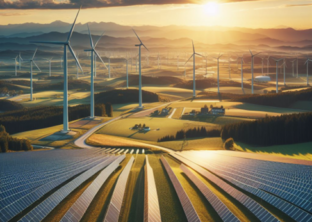“Green” ammonia for the energy transition – “Power to Ammonia“
SVP has recently been dealing a lot with the topic of hydrogen. If you look at the development of the listed companies like ITM, Ceres, Plug Power and Nel, there is a bubble bursting on the stock market, like the 3D companies did back then. The hydrogen sector is nowhere near mainstream, a lot of it is hyped but will probably catch on and become mainstream in the future. In the meantime, SVP is looking around for possible alternatives and has found one in ammonia.
Ammonia is a chemical compound of the elements nitrogen and hydrogen with the molecular formula NH3. It is a strong pungent smelling, colorless, water soluble and poisonous gas, which irritates to tears and has a suffocating effect. The compound is one of the most widely produced chemicals and the basic ingredient for the production of all other nitrogen compounds, but especially for the production of fertilizers. It is produced almost exclusively by the Haber-Bosch process from the elements hydrogen and nitrogen.
But why ammonia now – and as an energy source for an energy turnaround? The gas is a climate-neutral energy carrier if the hydrogen required for its production is not obtained from conventional natural gas but, for example, is produced by electrolysis using green electricity and only energy from renewable sources is used. The so-called “power-to-ammonia” process aims to make “power” from renewable energy sources transportable and storable by storing the energy chemically in the form of ammonia. The energy can then be released again by using ammonia directly as a carbon-free fuel or as a hydrogen supplier.

Ammonia, especially as a transport medium, could enable global trade in green energy for the first time. But why not hydrogen? The transport of hydrogen requires enormous investments. For example, in addition to new types of ships, port terminals would have to be built with appropriate cooling facilities to keep the hydrogen liquid at minus 253 degrees Celsius. This problem is much less acute with ammonia, which liquefies at minus 33 degrees Celsius. This means, for example, that about 50 percent more energy can be transported per ship than in hydrogen tankers. Economically, this is not insignificant. Ammonia, a climate polluter, is suddenly becoming a beacon of hope for the energy transition. According to the energy market research agency Argus Media, ammonia production could increase from the current level of around 180 million tons to one billion tons by 2050.
One of the world’s leading companies in the field of fertilizer production is the Norwegian company Yara. The company is aiming to take an early pole position in the market for “green” ammonia. The Norwegian peninsula of Herøya will be home to one of the first production facilities to produce ammonia in a CO2-neutral way – production is scheduled to switch in 2022.
That would be a milestone – considering that ammonia production accounts for around 1.8 percent of climate gas emissions worldwide. If the hydrogen required is produced “green,” all fertilizer production would become “green,” so to speak. But it is not only Yara that has recognized the potential in ammonia. Australia, for example, wants to build one of the largest power plants from solar and wind energy plants and produce ammonia with the Asian Renewable Energy Hub project. Chile and Saudi Arabia also have similar plans. The race for the energy source of the future has begun.

Dr. Volkhard Francke, Market Intelligence Senior Expert
Sources:
- WirtschaftsWoche 04/2021 www.wiwo.de
- Yara www.yara.com







